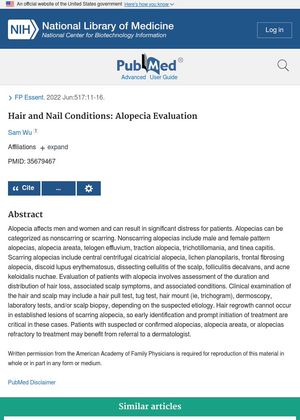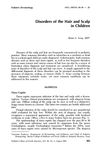Hair and Nail Conditions: Alopecia Evaluation
June 2022
in “PubMed”

TLDR Alopecia causes hair loss and should be treated early, especially scarring types where hair cannot regrow.
Alopecia, a condition causing hair loss, affects both men and women and can be categorized as nonscarring or scarring. Nonscarring alopecias include male and female pattern alopecias, alopecia areata, telogen effluvium, traction alopecia, trichotillomania, and tinea capitis. Scarring alopecias include central centrifugal cicatricial alopecia, lichen planopilaris, frontal fibrosing alopecia, discoid lupus erythematosus, dissecting cellulitis of the scalp, folliculitis decalvans, and acne keloidalis nuchae. Evaluating patients with alopecia involves assessing the duration and distribution of hair loss, associated scalp symptoms, and associated conditions. Clinical examination may include a hair pull test, tug test, hair mount, dermoscopy, laboratory tests, and/or scalp biopsy. Hair regrowth cannot occur in established lesions of scarring alopecia, so early identification and prompt initiation of treatment are critical. Patients with suspected or confirmed alopecias, alopecia areata, or alopecias refractory to treatment may benefit from referral to a dermatologist.
View this study on pubmed.ncbi.nlm.nih.gov →
Related

research Pattern Hair Loss in Men
Male pattern hair loss caused by follicular miniaturization; early diagnosis and treatment can reduce psychological burden.

research Disorders of the Hair and Scalp in Children
The document concludes that various hair and scalp disorders in children have specific treatments and proper diagnosis is essential.